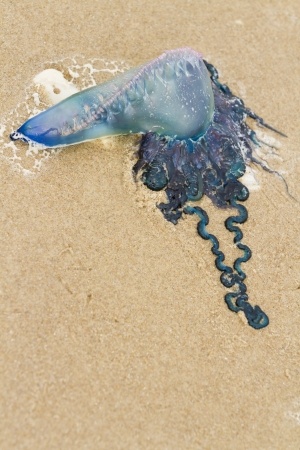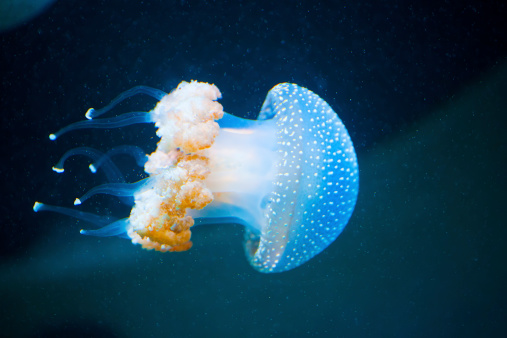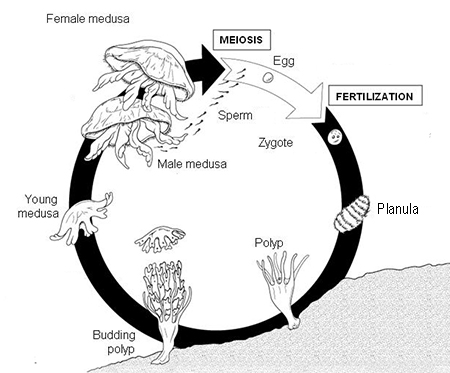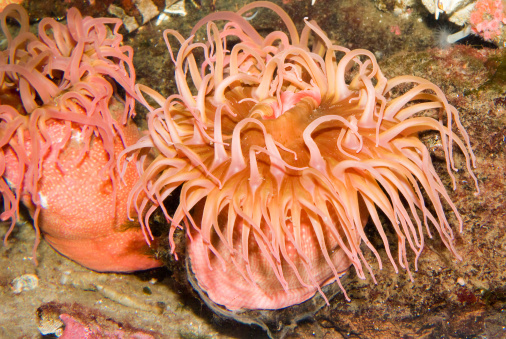Cnidarians are divided into three classes--Hydrozoa, Scyphozoa, and Anthozoa--and are characterized by what body form--medusa or polyp--they spend most of their lives as. Each class has its own special characteristics, but all three are cnidarians, thus they have some common features. What cell is the distinguishing feature of cnidarians? Once you have your answer, click the show me button to see if you're right.

All cnidarians have stinging cells called cnidocytes.
All cnidarians also have tentacles, tissue, a gastrovascular cavity, and two body forms--medusa and polyp.
In the activity below, click each tab to learn about the different classes of cnidarians.
Hydrozoa
Scyphozoa
Anthozoa
 This hydrozoan has washed up on a beach. It is called the Portuguese Man of War and has a medusa body form. |
- Hydrozoans can spend part of their lives in the medusa body form and part of their lives in the polyp form, but they usually spend longer periods in just one form.
- The fresh water Hydra, which is a hydrozoan, lives its life entirely in the polyp form.
- Another hydrozoan, the spine-chilling Portuguese Man of War, with tentacles that can dangle down to as far as 165 feet, lives its life mostly in the medusa form.
![Lifetrance at en.wikipedia [CC-BY-SA-3.0 (http://creativecommons.org/licenses/by-sa/3.0) or GFDL (http://www.gnu.org/copyleft/fdl.html)], via Wikimedia Commons](https://s3.amazonaws.com/cms.accelerate-ed.com/image/37e73b95-5410-41fd-bc83-60bafbd78ca0.jpg) This hydrozoan is attached to a plant. It is called the Hydra and has a polyp body form. |
- Most hydrozoans begin their lives as a polyp.
- The polyp can reproduce asexually by budding. The detached bud grows into a medusa form.
- The adult medusas release eggs and sperm in the water. The eggs become fertilized and the zygote eventually develops into a planula, which is a young polyp.
- The planula plants itself to a firm surface to grow into an adult polyp, starting the cycle all over again.

Scyphozoa
- Scyphozoans include the animals referred to as true jellyfish, such as the animal pictured.
- The name Scyphozoa comes from the Greek word Skyphos for cup and zoia for animal, thus the name means "cup animal."
- All scyphozoans are active predators that live out the majority of their lives in the medusa stage.
- They range in size from as small as your fingernail to as large as a small car.

Scyphozoa Reproduction
- Most scyphozoans begin their lives as a polyp. The polyp can reproduce asexually by budding. The detached bud grows into a medusa form, which is the form that most scyphozoans remain in for the rest of their lives.
- The adult medusas release eggs and sperm in the water. The eggs become fertilized and the zygote becomes a planula.
- The planula plants itself to a firm surface to grow into a very short-lived adult polyp, starting the cycle all over again.
- Most scyphozoans spend most of their lives as a medusa.

Anthozoa
- The word Anthozoa comes from the Greek word Anthos for flower and zoia for animal, thus anthozoans are "Flower Animals."
- Anthozoans are strictly polyps, including the brightly colored corals and sea anemones, such as the one pictured.
Anthozoan Reproduction
- Anthozoans remain in polyp form their entire life.
- The polyp can reproduce asexually through budding.
- The polyps can also reproduce sexually by releasing egg and sperm that combine to form a zygote that then develops into a planula.
- The planula lands and settles in place to grow into an adult polyp.
Test your understanding of the three classes of cnidarians by matching the word or phrase on the left to its correct category on the right.
|
Anthozoa
|
polyp only
medusa only
medusa and polyp
|
|
Hydrozoa
|
polyp only
medusa only
medusa and polyp
|
|
Scyphozoa
|
sea anemones
true jellyfish
corals
|
|
planula
|
sperm cell
asexual bud
young polyp
|
|
able to swim most its life
|
Hydrozoa
Scyphozoa
Anthozoa
|
Complete
